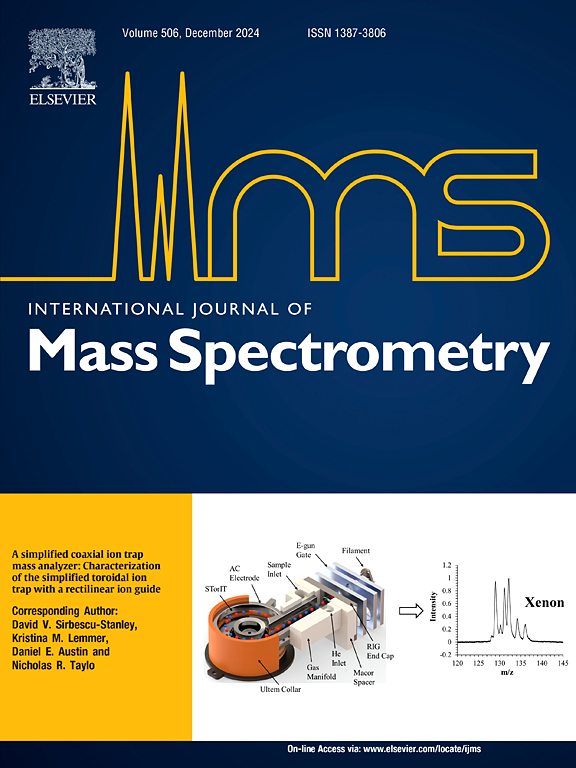Rapid and accurate identification of Illicium verum and its poisonous adulterant Illicium lanceolatum based on high-sensitivity VUV photoionization mass spectrometry
IF 1.7
3区 化学
Q3 PHYSICS, ATOMIC, MOLECULAR & CHEMICAL
引用次数: 0
Abstract
The occasional mix of the poisonous adulterant Illicium lanceolatum fruits in the Illicium verum fruits (Chinese star anise) sold in the agricultural market causes a food safety concern. Therefore, rapid differentiation between the fruits of these two species is essential for food safety. This paper reports a mass spectrometric recognition method between the Illicium verum and Illicium lanceolatum fruits. A high-sensitivity VUV photoionization time-of-flight mass spectrometer (PI-MS) directly sampled the volatile organics emitted from these two fruits via dynamic headspace. The assay results show that the mass peak of trans-anethole (m/z = 148) is predominant in the mass spectrum of Illicium verum, whereas no significant peak is observed at m/z 148 in the mass spectrum of Illicium lanceolatum. In contrast, the mass peak at m/z 154 with moderate intensity, associated with oxygenated monoterpenes, is detected in Illicium lanceolatum but not detected in Illicium verum. A developed chemical pattern recognition method achieved recognition with 100 % confidence between the Illicium verum and Illicium lanceolatum fruits. This study provides a new identification method using PI-MS to rapidly differentiate the Illicium verum and poisonous adulterant Illicium lanceolatum fruits. The advantages of soft ionization in PI-MS, coupled with its capability to detect volatile gases and the avoidance of complex sample pre-treatment steps, facilitate rapid and easily interpretable mass spectral detection.

基于高灵敏度紫外光离子化质谱法快速准确地鉴定茵陈及其有毒掺杂物茵陈
在农产品市场上销售的八角茴香果实中偶尔会混入有毒的掺杂物 Illicium lanceolatum,这引起了食品安全问题。因此,快速区分这两个品种的果实对食品安全至关重要。本文报告了一种识别八角和八角茴香果实的质谱方法。高灵敏度紫外光离子化飞行时间质谱仪(PI-MS)通过动态顶空直接对这两种水果散发的挥发性有机物进行采样。检测结果表明,反式茴香醚的质量峰(m/z = 148)在茵陈的质谱中占主导地位,而在茵陈的质谱中,m/z 148 处没有观察到明显的质量峰。相反,在 Illicium lanceolatum 中检测到了 m/z 154 的质量峰,强度适中,与含氧单萜有关,但在 Illicium verum 中未检测到。所开发的化学模式识别方法能以 100% 的置信度识别出 Illicium verum 和 Illicium lanceolatum 果实。这项研究提供了一种利用 PI-MS 快速鉴别马齿苋和有毒掺假马齿苋果实的新方法。PI-MS 中软电离的优势,加上其检测挥发性气体的能力,以及避免了复杂的样品预处理步骤,有助于快速和易于解释的质谱检测。
本文章由计算机程序翻译,如有差异,请以英文原文为准。
求助全文
约1分钟内获得全文
求助全文
来源期刊
CiteScore
3.60
自引率
5.60%
发文量
145
审稿时长
71 days
期刊介绍:
The journal invites papers that advance the field of mass spectrometry by exploring fundamental aspects of ion processes using both the experimental and theoretical approaches, developing new instrumentation and experimental strategies for chemical analysis using mass spectrometry, developing new computational strategies for data interpretation and integration, reporting new applications of mass spectrometry and hyphenated techniques in biology, chemistry, geology, and physics.
Papers, in which standard mass spectrometry techniques are used for analysis will not be considered.
IJMS publishes full-length articles, short communications, reviews, and feature articles including young scientist features.

 求助内容:
求助内容: 应助结果提醒方式:
应助结果提醒方式:


